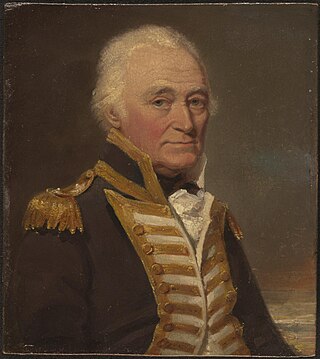| |||||
| Decades: | |||||
|---|---|---|---|---|---|
| See also: | |||||
The following lists events that happened during 1790 in Australia.
| |||||
| Decades: | |||||
|---|---|---|---|---|---|
| See also: | |||||
The following lists events that happened during 1790 in Australia.


Arthur Phillip was a British Royal Navy officer who served as the first governor of the Colony of New South Wales.

The history of Norfolk Island dates back to the fourteenth or fifteenth century when it was settled by Polynesian seafarers.

The First Fleet was a fleet of 11 British ships that brought the first British colonists and convicts to Australia. It was made up of two Royal Navy vessels, three store ships and six convict transports. On 13 May 1787 the fleet under the command of Captain Arthur Phillip, with over 1400 people, left from Portsmouth, England and took a journey of over 24,000 kilometres (15,000 mi) and over 250 days to eventually arrive in Botany Bay, New South Wales, where a penal colony would become the first British settlement in Australia.

HMS Sirius was the flagship of the First Fleet, which set out from Portsmouth, England, in 1787 to establish the first European colony in New South Wales, Australia. In 1790, the ship was wrecked on the reef, south east of Kingston Pier, in Slaughter Bay, Norfolk Island.

Vice Admiral John Hunter was an officer of the Royal Navy, who succeeded Arthur Phillip as the second Governor of New South Wales, serving from 1795 to 1800.

Philip Gidley King was a British politician who was the third Governor of New South Wales.

Launched in 1759, the third HMS Supply was a Royal Navy armed tender that played an important part in the foundation of the Colony of New South Wales. The Navy sold her in 1792. She then served commercially until about 1806.
Major Robert Ross was the officer in charge of the First Fleet garrison of marines, and Lieutenant-Governor of the convict settlement of Norfolk Island.
The history of Australia from 1788 to 1850 covers the early British colonial period of Australia's history. This started with the arrival in 1788 of the First Fleet of British ships at Port Jackson on the lands of the Eora, and the establishment of the penal colony of New South Wales as part of the British Empire. It further covers the European scientific exploration of the continent and the establishment of the other Australian colonies that make up the modern states of Australia.
The following lists events that happened during 1788 in Australia.
The following lists events that happened during 1789 in Australia.
The following lists events that happened during 1791 in Australia.
George Raper was a Royal Navy officer who as an able seaman joined the crew of HMS Sirius and the First Fleet to establish a colony at Botany Bay, New South Wales, now Australia. He is best known today for his watercolour sketches of the voyage and settlement, particularly birds and flowers of Sydney Cove.

Henry Lidgbird Ball was a Rear-Admiral in the Royal Navy of the British Empire. While Ball was best known as the commander of the First Fleet's HMS Supply, he was also notable for the exploration and the establishment of colonies around what is now Australia and New Zealand. Specifically, Ball explored the area around Port Jackson and Broken Bay, helped establish the Norfolk Island penal settlement, and discovered and named Lord Howe Island.
Thomas Jamison was a naval surgeon, who was surgeon mate on HMS Sirius as part First Fleet which founded Colony of New South Wales in 1788. He was surgeon at the Norfolk Island settlement, before returning to Sydney and becoming primary surgeon of colony. He was also involved in mercantile dealings which led to the Rum Rebellion, and its overthrow of Governor William Bligh.
William Bradley was a British naval officer and cartographer who was one of the officers who participated in the First Fleet to Australia. During this expedition, Bradley undertook extensive surveys and became one of the first of the settlers to establish relations with the aborigines, with whom he struck up a dialogue and whose customs and nature he studied extensively. He later however fell out with his aboriginal contacts and instead undertook a mission to gather food which ended with an eleven-month stay on Norfolk Island after a shipwreck.
Captain Henry Waterhouse was an English naval officer of the Royal Navy who became an early settler in the Colony of New South Wales, Australia. He imported to Australia the continent's first Spanish merino sheep, whose wool became one of the colony's best exports.
Peter Kenney Hibbs was an English mariner and a member of the First Fleet to Australia in 1788.

There are 20 known contemporary accounts of the First Fleet made by people sailing in the fleet, including journals and letters. The eleven ships of the fleet, carrying over 1,000 convicts, soldiers and seamen, left England on 13 May 1787 and arrived in Botany Bay between 18 and 20 January 1788 before relocating to Port Jackson to establish the first European settlement in Australia, a penal colony which became Sydney.
Norfolk Islanders, also referred to as just Islanders, are the inhabitants or citizens of Norfolk Island, an external territory of Australia. The Islanders have their own unique identity and are predominantly people of Pitcairn and English descent and to a lesser extent of Scottish and Irish.